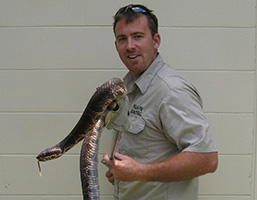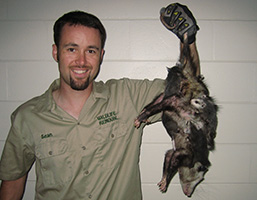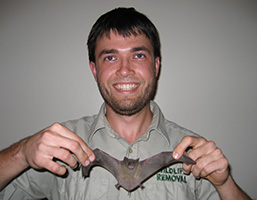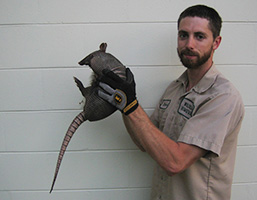Providing Education for Humane and Effective Wildlife Removal
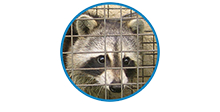
Wildlife Trapping
When it's necessary to remove animals, we focus on humane and effective trapping and relocation.
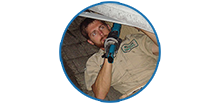
Home Repairs
A critical step - the identification and repair of any and all wildlife entry points into the home.
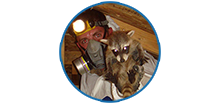
Animals in Attic
We specialize in the removal of animals in the attic - squirrels, raccoons, rats, mice, bats, and more.
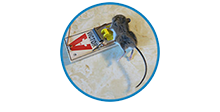
No Poisons!
We never use poisons in any part of our wildlife control, including rodent control. Poisons don't work!
Our Wildlife Removal Team in Action!
Wildlife Removal Educational Resources
Below you will find helpful instructions for solving many common nuisance wildlife problems. You will learn how to properly respond to your critter conflict, and learn what you can do by yourself, and what situations may require outside help. If you want the free services available in your town or city, click on Free Wildlife Services in Your Town for a directory of local help, from county agencies, to state fish & wildlife commissions to wildlife rehabilitators.
How To Remove A Wild Animal In The Attic
How To Keep Wild Animals Away
How To Trap Wild Animals
Wild Animal Repellent
What Is The Best Bait To Catch A Wild Animal?
Wild Animal Feces
How To Remove A Wild Animal Inside Your House
Remove Wild Animal On Your Roof
Remove Wild Animals Under Your Shed, or Porch
Remove Wild Animals Inside Your Wall
Animal Digging In Yard Or Next To House
Animals Eating Garden Or Landscaping
How To Clean Wild Animal Waste In Your Attic
Problems Caused By Nuisance Wildlife
How To Remove A Wild Animal In The Chimney
Scratching Sounds In The Attic Or Walls
How To Find Dead Animal
Attic Cleanup After Wildlife
Wildlife Odor Control Methods
Noises in the Attic
How to Get Rid Of Flying Squirrels
How To Get Rid Of Foxes
How To Get Rid Of Coyotes
How To Get Rid Of Chipmunks
How To Get Rid Of Beavers
How To Get Rid Of A Raccoon
How To Keep Raccoons Away
Raccoon Trapping
Raccoon Repellent
How To Kill A Raccoon
How To Get A Raccoon Out Of Your Attic
How To Keep Squirrels Away
How To Trap A Squirrel
Squirrel Repellent
How To Kill A Squirrel
How To Get A Squirrel Out Of Your Attic
How To Get Rid Of Opossums
How To Keep Opossums Away
How To Trap An Opossum
Opossum Repellent
How To Kill An Opossum
Get An Opossum Out Of Your Attic
How To Get Rid Of Skunks
About Skunks: Appearance, Biology
How To Keep Skunks Away
Skunk Trapping: How To Trap A Skunk
Skunk Repellent
How To Kill A Skunk
Get Skunks Out From Under A Shed
How To Get Rid Of Rats
How To Keep Rats Away
Rat Trapping: How To Trap A Rat
Rat Repellent
How To Kill A Rat
How To Get Rats Out Of Your Attic
How To Get Rid Of Bats
How To Keep Bats Away
Bat Trapping: How To Trap A Bat
Bat Repellent
How To Kill A Bat
How To Get Bats Out Of Your Attic
Animal Digging In Yard Or Next To House
How To Keep House Mice Away
How To Trap A House Mouse
House Mouse Repellent
How To Kill A Mouse
How To Get House Mice Out Of Your Attic
How To Get Rid Of Groundhogs
How To Keep Groundhogs Away
Groundhog Trapping: How To Trap A Groundhog
Groundhog Repellent
How To Kill A Groundhog
Get A Groundhog Out From Under A Shed
How To Get Rid Of Armadillos
How To Keep Armadillos Away
How To Trap An Armadillo
Armadillo Repellent
How to Kill an Armadillo
How To Get Rid Of Moles
How To Keep Moles Away
Mole Trapping: How To Trap A Mole
Mole Repellent
How To Kill A Mole
How To Get Rid Of Birds - Pigeons
How To Keep Pigeons Away
Pigeon Trapping: How To Trap A Pigeon
Pigeon Repellent
How To Kill A Pigeon
How To Get Pigeons Out Of Your Attic
How To Get Rid Of Snakes
How To Keep Snakes Away
Snake Trapping: How To Trap A Snake
Snake Repellents
How To Kill A Snake
Wildlife Tip of the Month: How To Trap Wild Animals
There are many different methods of dealing with wild animals on your property. Sometimes you can convince them to leave with scents they don't like or loud noises, but that won't always work. At times, you may need to trap the animal so it can be relocated instead. You can either do this yourself or hire a professional and the exact method will depend on the type of trap you choose to use. There are both live and kill traps available, with the obvious difference being that kill traps are designed to kill the animal instantly, while live traps can be used for relocation.
Special Considerations
Before starting the process of trapping an animal on your property, you will want to keep in mind that the solution may only be temporary. Unless you relocate the animal at a very far distance and take steps to prevent it (or another animal) from coming back, it will only be a temporary solution. Certain animals may even have a homing instinct that will lead them back to your home. Because of this, trapping works best in the case of an animal that is actually within your home as you will have the chance to seal their entry points before the animal, or another of the same species, returns.
Another very important consideration is the number of animals on your property and whether there are baby animals. If there are baby animals, you will need to wait until they grow to trap any wildlife. If you separate the babies from the mothers, you are essentially sentencing the baby animals to death as they will be unable to fend for themselves. To make matter worse, the mother will probably be worried about her babies. This means that if babies are present, you should wait a few months before trapping the wild animals, at which point it should be safe and humane to do so
Live Cage Traps
The ideal trap to use is a live cage trap, which is typically made from wire. You can find a wide range of sizes and manufacturers, allowing you to pick the right cage for your particular wildlife. To make it easier, the majority of retailers for these cages will indicate the ideal animal for each cage.
There are also various trap configurations for live cage ones, including both those that are solid/rigid and those which are collapsible. The collapsible traps take up less storage room, but the rigid ones are sturdier. You can also select a trap with one or two doors, and although two-door traps cost more, they make releasing the animal easier.
To use a live cage trap effectively, you want to place the bait behind its trigger mechanism. Also consider adding soil or leaves over the wire mesh on the bottom so of the cage so it blends into the environment. No matter the style of trap, you always want to put it on a level surface to reduce the risk of injury to the wild animal.


